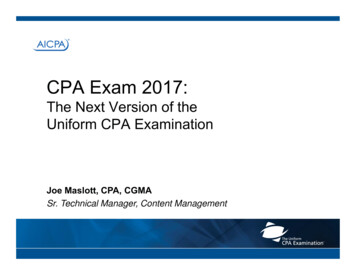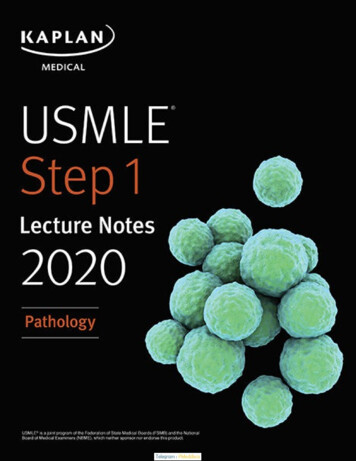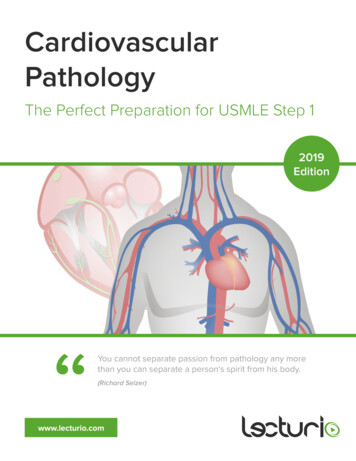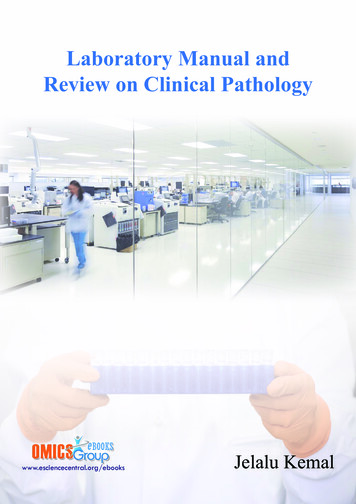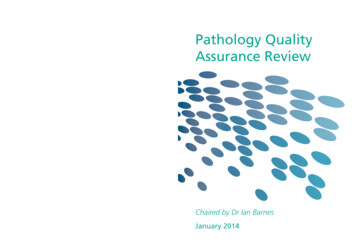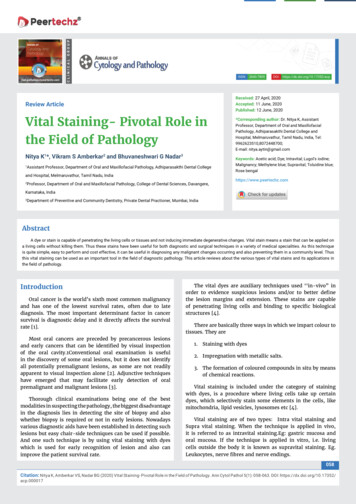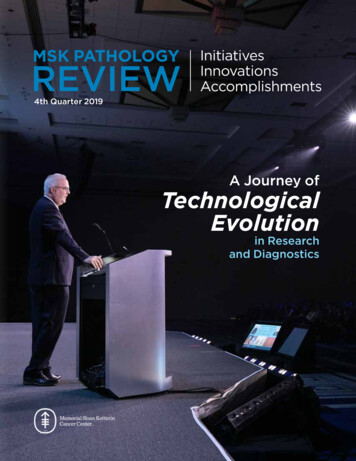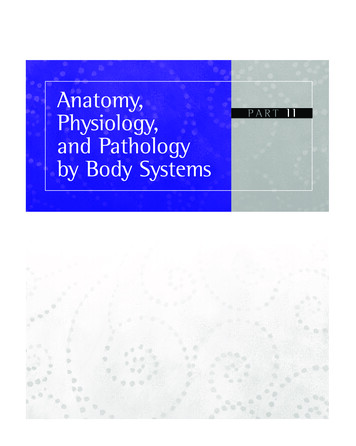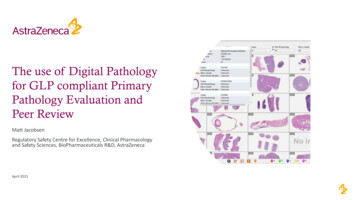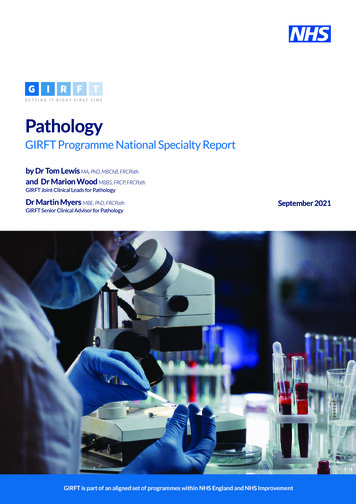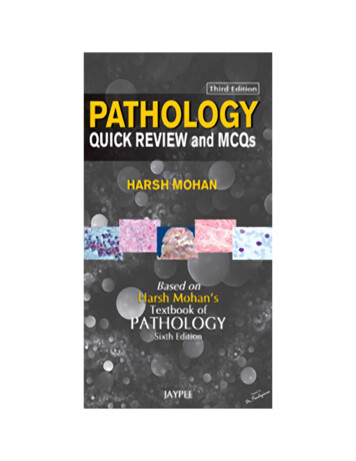
Transcription
PATHOLOGYQuick Review and MCQsBased onTextbook of Pathology6th EditionFor free online Web Images and Web Tables cited in the text,access on www.jaypeeonline.inScratch pin number available in the main textbook.
PATHOLOGYQuick Review and MCQsTHIRD EDITIONBased onTextbook of Pathology6th EditionHarsh Mohan MD, MNAMS, FICPath, FUICCProfessor & HeadDepartment of PathologyGovernment Medical CollegeSector-32 A, Chandigarh-160 031INDIAE-mail: drharshmohan@gmail.com JAYPEE BROTHERS MEDICAL PUBLISHERS (P) LTDSt Louis (USA) Panama City (Panama) New Delhi Ahmedabad BengaluruChennai Hyderabad Kochi Kolkata Lucknow Mumbai Nagpur
Published byJitendar P VijJaypee Brothers Medical Publishers (P) LtdCorporate Office4838/24 Ansari Road, Daryaganj, New Delhi 110 002, India, Phone: 91-11-43574357,Fax: 91-11-43574314Registered OfficeB-3 EMCA House, 23/23B Ansari Road, Daryaganj, New Delhi 110 002, IndiaPhones: 91-11-23272143, 91-11-23272703, 91-11-23282021, 91-11-23245672Rel: 91-11-32558559 Fax: 91-11-23276490, 91-11-23245683e-mail: jaypee@jaypeebrothers.com, Website: www.jaypeebrothers.comBranches 2/B, Akruti Society, Jodhpur Gam Road SatelliteAhmedabad 380 015 Phones: 91-79-26926233, Rel: 91-79-32988717Fax: 91-79-26927094 e-mail: ahmedabad@jaypeebrothers.com 202 Batavia Chambers, 8 Kumara Krupa Road, Kumara Park EastBengaluru 560 001 Phones: 91-80-22285971, 91-80-22382956, 91-80 22372664Rel: 91-80-32714073 Fax: 91-80-22281761 e-mail: bangalore@jaypeebrothers.com 282 IIIrd Floor, Khaleel Shirazi Estate, Fountain Plaza, Pantheon RoadChennai 600 008 Phones: 91-44-28193265, 91-44-28194897, Rel: 91-44-32972089Fax: 91-44-28193231 e-mail: chennai@jaypeebrothers.com 4-2-1067/1-3, 1st Floor, Balaji Building, Ramkote Cross RoadHyderabad 500 095 Phones: 91-40-66610020, 91-40-24758498, Rel: 91-40-32940929Fax: 91-40-24758499, e-mail: hyderabad@jaypeebrothers.com No. 41/3098, B & B1, Kuruvi Building, St. Vincent RoadKochi 682 018, Kerala Phones: 91-484-4036109, 91-484-2395739, 91-484-2395740e-mail: kochi@jaypeebrothers.com 1-A Indian Mirror Street, Wellington SquareKolkata 700 013 Phones: 91-33-22651926, 91-33-22276404, 91-33-22276415Fax: 91-33-22656075, e-mail: kolkata@jaypeebrothers.com Lekhraj Market III, B-2, Sector-4, Faizabad Road, Indira NagarLucknow 226 016 Phones: 91-522-3040553, 91-522-3040554e-mail: lucknow@jaypeebrothers.com 106 Amit Industrial Estate, 61 Dr SS Rao Road, Near MGM Hospital, ParelMumbai 400 012 Phones: 91-22-24124863, 91-22-24104532,Rel: 91-22-32926896 Fax: 91-22-24160828, e-mail: mumbai@jaypeebrothers.com “KAMALPUSHPA” 38, Reshimbag, Opp. Mohota Science College, Umred RoadNagpur 440 009 (MS) Phone: Rel: 91-712-3245220Fax: 91-712-2704275 e-mail: nagpur@jaypeebrothers.comNorth America Office1745, Pheasant Run Drive, Maryland Heights (Missouri), MO 63043, USA, Ph: 001-636-6279734e-mail: jaypee@jaypeebrothers.com, anjulav@jaypeebrothers.comCentral America OfficeJaypee-Highlights Medical Publishers Inc., City of Knowledge, Bld. 237, Clayton,Panama City, Panama, Ph: 507-317-0160Pathology Quick Review and MCQs 2010, Harsh MohanAll rights reserved. No part of this publication should be reproduced, stored in a retrieval system, ortransmitted in any form or by any means: electronic, mechanical, photocopying, recording, orotherwise, without the prior written permission of the author and the publisher.This book has been published in good faith that the material provided by author is original.Every effort is made to ensure accuracy of material, but the publisher, printer and author will notbe held responsible for any inadvertent error(s). In case of any dispute, all legal matters are tobe settled under Delhi jurisdiction only.First Edition : 2000Second Edition : 2005Third Edition : 2010Assistant Editors: Praveen Mohan, Tanya Mohan, Sugandha MohanISBN: 978-81-8448-778-7Typeset at JPBMP typesetting unitPrinted at Ajanta Press
He whose deeds are virtuous,is rewarded with purity and knowledge. Theactionsdonewithpassioncausemisery, while he whose deeds are dark is cursed with ignorance. (The Bhagvadgita, Chapter XIV: Verse 16) To all those who matter so much to me:My family—wife Praveen anddaughters Tanya, SugandhaandAll students and colleagues—former and present,with whom I had occasion to share and interact.
PrefaceThe release of the Third Revised Edition of Pathology QuickReview and MCQs simultaneous to the release of the SixthEdition of its parent book, Textbook of Pathology, marks thecompletion of 10 years since its first launch. The satisfiedusers of this ancillary handy learning material during thedecade have surely encouraged me and the publisher tocontinue the convention of providing the baby-book as apackage with the mother-book. Besides, with this edition, athird learning resource has been added for the benefit ofusers—the buyer of the package now gets free access to thehighly useful website containing all the images and tablesincluded in the main textbook which can be used as anadditional learning tool by the students for self-assessmentand quick review of the subject while teachers may use thedownloadable figures and tables for inclusion in theirlectures.The companion book is the abridged version of sixthrevised edition of my textbook and has been aimed to servethe following twin purposes as before:For beginner students of Pathology who have undertakenan in-depth study of the main book earlier may like to revisethe subject in a relatively short time from this book and mayalso undertake self-test on the MCQs given at the end ofeach chapter.For senior students and interns preparing for theirpostgraduate and other entrance examinations who areconfronted with revision of all medical subjects besidespathology in a limited time, this book is expected to act asthe main source material for quick revision and also exposethem to MCQs based on essential pathology.Pathology Quick Review book has the same 30 chaptersdivided into sections as in the main textbook—Section I:Chapters 1-11 (General Pathology and Basic Techniques),Section II: Chapters 12-14 (Haematology and Lymphoreticular Tissues), Section III: Chapters 15-30 (SystemicPathology) and an Appendix containing essential NormalValues. Each major heading in the small book has crossreferences of page numbers of the 6th edition of my textbookso that an avid and inquisitive reader interested insimultaneous consultation of the topic or for clarification ofa doubt, may refer to it conveniently. Self-Assessment byMCQs given at the end of every chapter which keeps thisbook apart from other similar books, has over 100 new
viiiPathology Quick Reviewquestions raising their number to over 700 MCQs in therevised edition, besides modifying many old ones. Whilemuch more knowledge has been condensed in the babybook from the added material in the main textbook, efforthas been made not to significantly increase the volume ofthis book. It is hoped that the book with enhanced andupdated contents continues to be user-friendly in learningthe essential aspects of pathology, while at the same time,retaining the ease with which it can be conveniently carriedby the users in the pocket of their white coats.Preparation of this little book necessitated selection fromenhanced information contained in the revised edition ofmy textbook and therefore, required application of mydiscretion, combined with generous suggestions fromcolleagues and users of earlier edition. In particular, valuablesuggestions and help came from Drs Shailja and Tanvi,Senior Residents in the department, which is gratefullyacknowledged.I thank profusely the entire staff of M/s Jaypee BrothersMedical Publishers (P) Ltd. for their ever smiling supportand cooperation in completion of this book in a relativelyshort time, just after we had finished the mammoth task ofrevision work of sixth edition of the main textbook.Finally, although sincere effort has been made to be asaccurate as possible, element of human error is still likely; Ishall humbly request users to continue giving their valuablesuggestions directed at further improvements of its contents.Government Medical CollegeHarsh MohanSector-32 AMD, MNAMS, FICPath, FUICCChandigarh-160 031Professor and HeadINDIADepartment of PathologyE-mail: drharshmohan@gmail.com
ContentsSECTION I: GENERAL PATHOLOGY ANDBASIC TECHNIQUES1.2.3.4.5.6.7.8.9.10.11.Introduction to Pathology . 01Techniques for the Study of Pathology . 06Cell Injury and Cellular Adaptations . 14Immunopathology Including Amyloidosis . 41Derangements of Homeostasis andHaemodynamics . 63Inflammation and Healing . 92Infectious and Parasitic Diseases . 131Neoplasia . 145Environmental and Nutritional Diseases . 185Genetic and Paediatric Diseases . 203Basic Diagnostic Cytology . 212SECTION II: HAEMATOLOGY ANDLYMPHORETICULAR TISSUES12. Introduction to Haematopoietic System andDisorders of Erythroid Series . 22613. Disorders of Platelets, Bleeding Disorders andBasic Transfusion Medicine . 26614. Disorders of Leucocytes andLymphoreticular Tissues . 281SECTION III: SYSTEMIC .29.30.The Blood Vessels and Lymphatics .The Heart .The Respiratory System .The Eye, ENT and Neck .The Oral Cavity and Salivary Glands .The Gastrointestinal Tract .The Liver, Biliary Tract and Exocrine Pancreas .The Kidney and Lower Urinary Tract .The Male Reproductive System and Prostate .The Female Genital Tract .The Breast .The Skin .The Endocrine System .The Musculoskeletal System .Soft Tissue Tumours .The Nervous System PPENDIX: Normal Values . 750Index . 757
Abbreviations UsedThroughout the book following abbreviations have been used:G/Afor Gross Appearance.M/Efor Microscopic Examination.EMfor Electron Microscopy.IFfor Immunofluorescence Microscopy.
Chapter11Introduction to PathologyLesions are the characteristic changes in tissues and cells produced bydisease in an individual or experimental animal.Pathologic changes or morphology consist of examination of diseasedtissues.Pathologic changes can be recognised with the naked eye (gross ormacroscopic changes) or studied by microscopic examination of tissues.Causal factors responsible for the lesions are included in etiology ofdisease (i.e. ‘why’ of disease).Mechanism by which the lesions are produced is termed pathogenesis ofdisease (i.e. ‘how’ of disease).Functional implications of the lesion felt by the patient are symptoms andthose discovered by the clinician are the physical signs.EVOLUTION OF PATHOLOGY (p. 1)Pathology as the scientific study of disease processes has its deep roots inmedical history. Since the beginning of mankind, there has been desire as wellas need to know more about the causes, mechanisms and nature of diseases.The answers to these questions have evolved over the centuries—fromsupernatural beliefs to the present state of our knowledge of modern pathology. FROM RELIGIOUS BELIEFS AND MAGIC TO RATIONAL APPROACH(PREHISTORIC TIME TO AD 1500) (p. 2)Present-day knowledge of primitive culture prevalent in the world in prehistorictimes reveals that religion, magic and medical treatment were quite linked toeach other in those times. The earliest concept of disease understood by thepatient and the healer was the religious belief that disease was the outcome of‘curse from God’ or the belief in magic that the affliction had supernatural originfrom ‘evil eye of spirits.’ To ward them off, priests through prayers andsacrifices, and magicians by magic power used to act as faith-healers andinvoke supernatural powers and please the gods. Remnants of ancientsuperstitions still exist in some parts of the world.Introduction to PathologyPatient is the person affected by disease.Chapter 1STUDY OF DISEASES (p. 1)The word ‘Pathology’ is derived from two Greek words—pathos meaningsuffering, and logos meaning study. Pathology is, thus, scientific study ofstructure and function of the body in disease; or in other words, pathologyconsists of the abnormalities that occur in normal anatomy (including histology)and physiology owing to disease. Knowledge and understanding of pathologyis essential for all would-be doctors, general medical practitioners andspecialists. Remember the prophetic words of one of the eminent founders ofmodern medicine in late 19th and early 20th century, Sir William Osler, “Yourpractice of medicine will be as good as your understanding of pathology.”Since pathology is the study of disease, then what is disease? In simplelanguage, disease is opposite of health i.e. what is not healthy is disease.Health may be defined as a condition when the individual is in complete accordwith the surroundings, while disease is loss of ease (or comfort) to the body(i.e. dis-ease).It is important for a beginner in pathology to be familiar with the languageused in pathology:
2Section IGeneral Pathology and Basic TechniquesBut the real practice of medicine began with Hippocrates (460–370 BC),the great Greek clinical genius of all times and regarded as ‘the father ofmedicine’ (Web Image 1.1). Hippocrates followed rational and ethical attitudesin practice and teaching of medicine as expressed in the collection of writingsof that era. He firmly believed in study of patient’s symptoms and describedmethods of diagnosis.Hippocrates introduced ethical concepts in the practice of medicine and isrevered by the medical profession by taking ‘Hippocratic oath’ at the time ofentry into practice of medicine.Hippocratic teaching was propagated in Rome by Roman physicians,notably by Cornelius Celsus (53 BC-7 AD) and Cladius Galen (130–200 AD).Celsus first described four cardinal signs of inflammation—rubor (redness),tumor (swelling), calor (heat), and dolor (pain). Galen postulated humoraltheory, later called Galenic theory.The hypothesis of disequilibrium of four elements constituting the body(Dhatus) similar to Hippocratic doctrine finds mention in ancient Indian medicinebooks compiled about 200 AD—Charaka Samhita and Sushruta Samhita. FROM HUMAN ANATOMY TO ERA OF GROSS PATHOLOGY(AD 1500 TO 1800) (p. 3)The backwardness of Medieval period was followed by the Renaissanceperiod i.e. revival of leaning. Dissection of human body was started byVesalius (1514–1564) on executed criminals. His pupils, Gabriel Fallopius(1523–1562) who described human oviducts (Fallopian tubes) and Fabriciuswho discovered lymphoid tissue around the intestine of birds (bursa of Fabricius)further popularised the practice of human anatomic dissection for whichspecial postmortem amphitheatres came in to existence in various parts ofancient Europe (Web Image 1.2).Antony van Leeuwenhoek (1632–1723), a cloth merchant by profession inHolland, during his spare time invented the first ever microscope.The credit for beginning of the study of morbid anatomy (pathologicanatomy), however, goes to Italian anatomist-pathologist, Giovanni B. Morgagni(1682–1771). He laid the foundations of clinicopathologic methodology in thestudy of disease and introduced the concept of clinicopathologic correlation(CPC), establishing a coherent sequence of cause, lesions, symptoms, andoutcome of disease (Web Image 1.3).Sir Percival Pott (1714–1788), famous surgeon in England, identified thefirst ever occupational cancer in the chimney sweeps in 1775 and discoveredchimney soot as the first carcinogenic agent. However, the study of anatomyin England during the latter part of 18th Century was dominated by the twoHunter brothers: John Hunter (1728–1793), a student of Sir Percival Pott,rose to become greatest surgeon-anatomist of all times and he, together withhis elder brother William Hunter (1718–1788) who was a reputed anatomistobstetrician (or man-midwife), started the first ever museum of pathologicanatomy (Web Image 1.4).R.T.H. Laennec (1781–1826), a French physician, dominated the earlypart of 19th century by his numerous discoveries. He described several lungdiseases (tubercles, caseous lesions, miliary lesions, pleural effusion,bronchiectasis), chronic sclerotic liver disease (later called Laennec’s cirrhosis)and invented stethoscope.Morbid anatomy attained its zenith with appearance of Carl F. vonRokitansky (1804–1878), self-taught German pathologist who performed nearly30,000 autopsies himself. ERA OF TECHNOLOGY DEVELOPMENT ANDCELLULAR PATHOLOGY (AD 1800 TO 1950s) (p. 4)Pathology started developing as a diagnostic discipline in later half of the 19thcentury with the evolution of cellular pathology which was closely linked to
3Chapter 1Introduction to Pathologytechnology advancements in machinery manufacture for cutting thin sectionsof tissue, improvement in microscope, and development of chemical industryand dyes for staining.The discovery of existence of disease-causing micro-organisms wasmade by French chemist Louis Pasteur (1822–1895). Subsequently, G.H.A.Hansen (1841–1912) in Germany identified Hansen’s bacillus as causativeagent for leprosy (Hansen’s disease) in 1873.Developments in chemical industry helped in switch over from earlierdyes of plant and animal origin to synthetic dyes. The impetus for theflourishing and successful dye industry came from the works of numerouspioneers as under:Paul Ehrlich (1854–1915), described Ehrlich’s test for urobilinogen usingEhrlich’s aldehyde reagent, staining techniques of cells and bacteria, and laidthe foundations of clinical pathology (Web Image 1.5).Christian Gram, who developed bacteriologic staining by crystal violet.D.L. Romanowsky, Russian physician, who developed stain for peripheralblood film using eosin and methylene blue derivatives.Robert Koch, German bacteriologist who, besides Koch’s postulate andKoch’s phenomena, developed techniques of fixation and staining foridentification of bacteria, discovered tubercle bacilli in 1882 and cholera vibrioorganism in 1883.May-Grunwald and Giemsa developed blood stains.Sir William Leishman described Leishman’s stain for blood films.Robert Feulgen described Feulgen reaction for DNA staining.Until the end of the 19th century, the study of morbid anatomy hadremained largely autopsy-based and thus had remained a retrospective science.Rudolf Virchow (1821–1905) in Germany is credited with the beginning ofmicroscopic examination of diseased tissue at cellular level and thus beganhistopathology as a method of investigation. Virchow gave two majorhypotheses:All cells come from other cells.Disease is an alteration of normal structure and function of these cells.Virchow came to be referred as Pope in pathology in Europe and is aptlyknown as the ‘father of cellular pathology’ (Web Image 1.6).The concept of frozen section examination when the patient was still on theoperation table was introduced by Virchow’s student, Julius Cohnheim(1839–1884).The concept of surgeon and physician doubling up in the role of pathologistwhich started in the 19th century continued as late as the middle of the 20thcentury in most clinical departments. Assigning biopsy pathology work tosome faculty member in the clinical department was common practice; that iswhy some of the notable pathologists of the first half of 20th century hadbackground of clinical training.A few other landmarks in further evolution of modern pathology in this eraare as follows:Karl Landsteiner (1863–1943) described the existence of major humanblood groups in 1900 and was awarded Nobel prize in 1930 and is consideredfather of blood transfusion (Web Image 1.7).Ruska and Lorries in 1933 developed electron microscope which aided thepathologist to view ultrastructure of cell and its organelles.The development of exfoliative cytology for early detection of cervical cancerbegan with George N. Papanicolaou (1883–1962), in 1930s who is known as‘father of exfoliative cytology’ (Web Image 1.8).Another pioneering contribution in pathology in the 20th century was by aneminent teacher-author, William Boyd (1885–1979), dominated and inspiredthe students of pathology all over the world due to his flowery language andlucid style for about 50 years till 1970s (Web Image 1.9).
4MODERN PATHOLOGY (1950s TO PRESENT TIMES) (p. 6)Section IGeneral Pathology and Basic TechniquesThe strides made in the latter half of 20th century until the beginning of 21stcentury have made it possible to study diseases at molecular level, andprovide an evidence-based and objective diagnosis and enable the physicianto institute appropriate therapy. Some of the revolutionary discoveries duringthis time are as under (Web Image 1.10):Description of the structure of DNA of the cell by Watson and Crick in 1953.Identification of chromosomes and their correct number in humans (46) byTijo and Levan in 1956.Identification of Philadelphia chromosome t(9;22) in chronic myeloidleukaemia by Nowell and Hagerford in 1960 as the first chromosomalabnormality in any cancer.Flexibility and dynamism of DNA invented by Barbara McClintock for whichshe was awarded Nobel prize in 1983.In 1998, researchers in US found a way of harvesting stem cells, a type ofprimitive cells, from embryos and maintaining their growth in the laboratory,and thus started the era of stem cell research. Stem cells are seen by manyresearchers as having virtually unlimited application in the treatment of manyhuman diseases such as Alzheimer’s disease, diabetes, cancer, strokes, etc.In April 2003, Human Genome Project (HGP) consisting of a consortium ofcountries, was completed which coincided with 50 years of description of DNAdouble helix by Watson and Crick in April 1953. The sequencing of humangenome reveals that human genome contains approximately 3 billion of thebase pairs, which reside in the 23 pairs of chromosomes within the nucleus ofall human cells. Each chromosome contains an estimated 30,000 genes in thehuman genome.These inventions have set in an era of human molecular biology which isno longer confined to research laboratories but is ready for application as amodern diagnostic and therapeutic tool.SUBDIVISIONS OF PATHOLOGY (p. 7)Human pathology is the largest branch of pathology. It is conventionallydivided into General Pathology dealing with general principles of disease, andSystemic Pathology that includes study of diseases pertaining to the specificorgans and body systems.A. HISTOPATHOLOGY. Histopathology, used synonymously with anatomicpathology, pathologic anatomy, or morbid anatomy, is the classic method ofstudy and still the most useful one which has stood the test of time. It includesthe following 3 main subdivisions:1. Surgical pathology deals with the study of tissues removed from theliving body.2. Forensic pathology and autopsy work includes the study of organs andtissues removed at postmortem for medicolegal work and for determining theunderlying sequence and cause of death.3. Cytopathology includes study of cells shed off from the lesions (exfoliativecytology) and fine-needle aspiration cytology (FNAC) of superficial and deepseated lesions for diagnosis.B. HAEMATOLOGY deals with the diseases of blood.C. CHEMICAL PATHOLOGY includes analysis of biochemical constituents ofblood, urine, semen, CSF and other body fluids.
5SELF ASSESSMENT1.3.4.6.7.8.9.10.11.12.KEY1 D5 D9 B2 A6 A10 A3 B7 D11 D4 A8 B12 C Introduction to Pathology5.Chapter 12.The concept of clinicopathologic correlation (CPC) by study ofmorbid anatomy was introduced by:A. HippocratesB. VirchowC. John HunterD. MorgagniThe first ever museum of pathologic anatomy was developed by:A. John HunterB. RokitanskyC. Rudolf VirchowD. MorgagniABO human blood group system was first described by:A. Edward JennerB. Karl LandsteinerC. HippocratesD. LaennecFrozen section was first introduced by:A. CohnheimB. AckermanC. VirchowD. FeulgenElectron microscope was first developed by:A. Barbara McClintockB. Watson and CrickC. Tijo and LevanD. Ruska and LorriesStructure of DNA of the cell was described by:A. Watson and CrickB. Tijo and LevanC. Ruska and LorriesD. Barbara McClintockFlexibilty and dynamism of DNA was invented by:A. Watson and CrickB. Tijo and LevanC. Ruska and LorriesD. Barbara McClintockFather of cellular pathology is:A. Carl RokitanskyB. Rudolf VirchowC. G. MorgagniD. FT SchwannHumans genome consists of following number of genes:A. 20,000B. 30,000C. 50,000D. 100,000Stem cell research consists of:A. Human cells grown in vitroB. Plant cells grown in vitroC. Cadaver cells grown in vitroD. Synonymous with PCRPCR technique was introduced by:A. Ian WilmutB. WatsonC. Nowell HagerfordD. Kary MullisHuman genome project was completed in:A. 2001B. 2002C. 2003D. 2004
6Chapter2Techniques for the Study of PathologySection IAUTOPSY PATHOLOGY (p. 9)General Pathology and Basic TechniquesProfessor William Boyd in his unimitable style wrote ‘Pathology had its beginningon the autopsy table’. The significance of study of autopsy in pathology issummed up in Latin inscription in an autopsy room translated in English as“The place where death delights to serve the living’.Traditionally, there are two methods for carrying out autopsy:1. Block extraction of abdominal and thoracic organs.2. In situ organ-by-organ dissection.The study of autopsy throws new light on the knowledge and skills of bothphysician as well as pathologist. The main purposes of autopsy are as under:1. Quality assurance of patientcare by:i) confirming the cause of death;ii) establishing the final diagnosis; andiii) study of therapeutic response to treatment.2. Education of the entire team involved in patientcare by:i) making autopsy diagnosis of conditions which are often missedclinicallyii) discovery of newer diseases made at autopsyiii) study of demography and epidemiology of diseases; andiv) education to students and staff of pathology.Declining autopsy rate throughout world in the recent times is owing to thefollowing reasons:1. Higher diagnostic confidence made possible by advances in imagingtechniques e.g. CT, MRI, angiography etc.2. Physician’s fear of legal liability on being wrong.SURGICAL PATHOLOGY (p. 9)Surgical pathology is the classic and time-tested method of tissue diagnosismade on gross and microscopic study of tissues.With technology development and advances made in the dye industry inthe initial years of 20th Century, the speciality of diagnostic surgical pathologyby biopsy developed. SURGICAL PATHOLOGY PROTOCOL (p. 10)REQUEST FORMS. It must contain the entire relevant information about thecase and the disease (history, physical and operative findings, results of otherrelevant biochemical/haematological/radiological investigations, and clinicaland differential diagnosis) and reference to any preceding cytology or biopsyexamination done in the pathology services.TISSUE ACCESSION. The laboratory staff receiving the biopsy specimenmust always match the ID of the patient on the request form with that on thespecimen container. For routine tissue processing by paraffin-embeddingtechnique, the tissue must be put in either appropriate fixative solution (mostcommonly 10% formol-saline or 10% buffered formalin) or received freshunfixed. For frozen section, the tissue is always transported fresh-unfixed.GROSS ROOM. Proper gross tissue cutting, gross description and selectionof representative tissue sample in larger specimens is a crucial part of thepathologic examination of tissue submitted.
Calcified tissues and bone are subjected to decalcification to remove themineral and soften the tissue by treatment with decalcifying agents such asacids and chelating agents (most often aqueous nitric acid).QUALITY CONTROL. An internal quality control by mutual discussion incontroversial cases and self-check on the quality of sections can be carried outinformally in the set up. Presently, external quality control programme for theentire histopathology laboratory is also available.HISTOPATHOLOGIST AND THE LAW. In equivocal biopsies and controversialcases, it is desirable to have internal and external consultations to avoidallegations of negligence and malpractice.SPECIAL STAINS (HISTOCHEMISTRY) (p. 11)In certain ‘special’ circumstances when the pathologist wants to demonstratecertain specific substances or constituents of the cells to confirm etiologic,histogenic or pathogenetic components, special stains (also termedhistochemical stains), are employed.Some of the substances for which special stains are commonly used in asurgical pathology laboratory are amyloid, carbohydrates, lipids, proteins,nucleic acids, connective tissue, microorganisms, neural tissues, pigments,minerals; these stains are listed in Web Table 2.1.Techniqu
pathology in a limited time, this book is expected to act as the main source material for quick revision and also expose them to MCQs based on essential pathology. Pathology Quick Review book has the same 30 chapters divided into sections as in the main textbook—Section I
